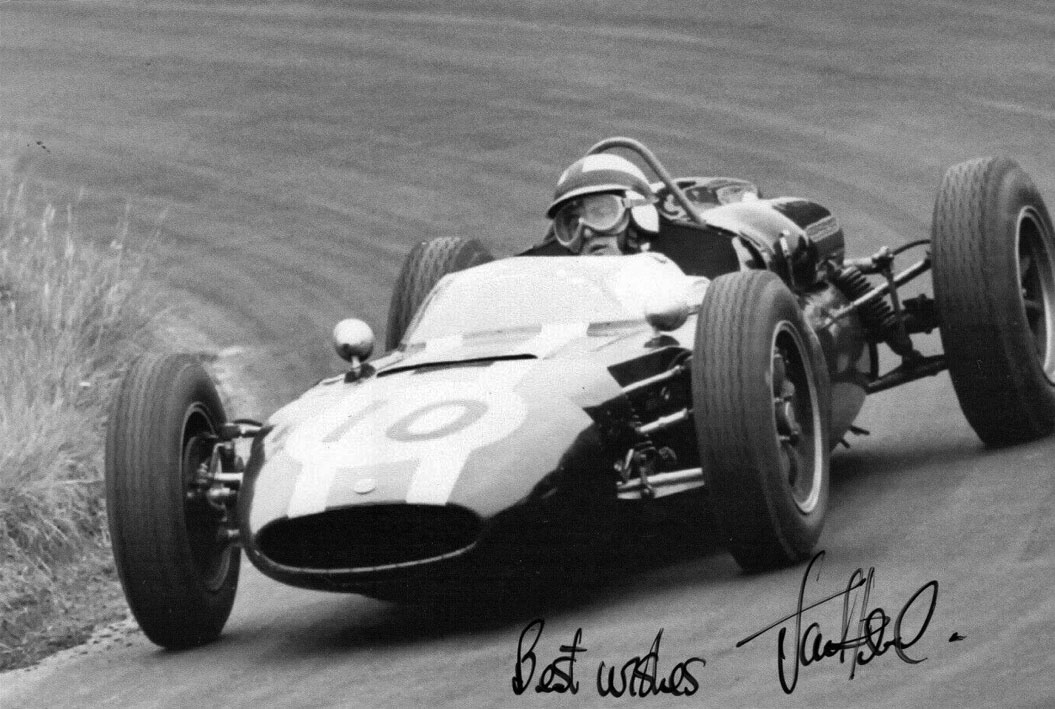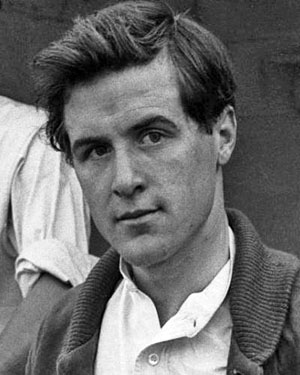Jack Rex C Lewis (born 1 November 1936 in Stroud, Gloucestershire) is a British former racing driver, born in England to a Welsh family.
Lewis’ racing career began in Formula Three. In 1958 Lewis bought a Formula Three Cooper-Norton from Cheltenham based Ivor Bueb and made his debut at Mallory Park, remarkably coming fourth. At Brands Hatch he made front page news for surviving a crash – a lucky photographer captured Jack’s upside-down Cooper showing Jack’s hand appearing to hold the car up. Just a week later he came first at Full Sutton and then won again at Oulton Park. In his first season in Formula 3 he raced 13 times – he won three of his races and was on the podium for a further four.
A year later, in a Formula Two Cooper-Climax Lewis won his first F2 race at Paris Montlhéry – winning by over two minutes. The following year Lewis’ determination paid off and he took the F2 champion title – ahead of Australian World Champion Jack Brabham.
The following year, he tried his hand at Formula One and purchased a Cooper T53 from the Surbiton factory. He made his Grand Prix debut at the Belgian Grand Prix in Spa in June 1961. His maiden season showed much promise – qualifying often mid-grid and finishing ninth in his first ever race and at the Nürburgring. He achieved fourth in Italy.
Aside from Stirling Moss, Lewis was the only independent driver to score any points in 1961 and was listed as a Grade A driver for the following year.
In 1962 Lewis formed the Ecurie Galloise (Welsh Racing Team) sponsored by the Western Sporting Press and his father’s business H&L Motors of Stroud – of which Lewis was now also a director. He bought a 1961/62 BRM V8 to race, but the car was unsatisfactory and eventually went back to the factory. He had no option but to return to his Cooper which he used the previous season. Although he achieved seventh place at the Dutch Grand Prix, it was overall a disappointing season for Lewis. The politics of F1 were beginning to affect him – he had been quicker than three works drivers at Monaco, yet had been denied a starting slot by the organisers. Lewis survived a few dangerous moments – losing a wheel at speed at Oulton Park and ramming Graham Hill in the French Grand Prix. He participated in 10 Formula One World Championship Grands Prix in all, scoring a total of three championship points.
By 1963, feeling despondent, Lewis retired from a promising racing career and took on a farm in Llandovery, Carmarthenshire where he bred Arab horses. Info from Wiki
Bio by Stephen Latham
Born in Stroud, Gloucestershire, on the 1st November 1936, Jack Rex Lewis had a rapid rise through F2 and F3, winning the British F2 title in 1960, and would record nine starts in the F1 World Championship in 1961 and 1962. His father used to race motorbikes before the War and ran H&L Motors and Jack himself first started competing on motorbikes. However, his interest lay in four wheels and after having a number of lessons at the Cooper Racing School at Brands Hatch he bought an ex-Ivor Bueb Cooper-Norton to contest Formula 3 in 1958.
Jack quickly showed promise, winning at Full Sutton in May then twice at Oulton Park in June and July, and was second to Stuart Lewis-Evans at the World Sports Trophy race at Brands Hatch. He came second to Trevor Taylor at Silverstone’s Commander Yorke Trophy in August though had been well placed in this race. He had fitted an extra fuel tank, hoping that the extra weight would be more than compensated for by not having to refuel, but the tank split and he was forced to pit. However, he was fortunate to survive with just shock and burns to his hands in a crash at Brands Hatch with a a photograph of his Cooper, in mid-air and upside down, later appearing on the front page of a newspaper. He was sixth in the Lavant Cup at Goodwood and his total for the year was three wins, three second places and a third. In 1959 he moved up to Formula 2 with a Cooper T45-Climax though had to fight all year to get his entries accepted. Racing the H&L Motors Cooper his first race saw him finish eleventh in Goodwood’s Lavant Cup at the end of March, then fourteenth in the British Empire Trophy at Oulton Park and seventh in the Aintree 200. Then came his first victory, taking the Prix de Paris race at Monthlery in May and in the same month he was seventh at Pau. He failed to qualify for the London Trophy at Crystal Palace then in July was tenth at Reims and eighth in the Trophy d’Auvergne at Clermont Ferrand though retired due to an accident after 13 laps at Rouen. In the following month he did not qualify at Brands Hatch though in October he came second in the Monthlery Coupe de Salon behind Harry Schell.
1960 saw him become a regular race winner and he took the Autocar British Formula 2 Championship title. He did not attend the season’s opening race at Syracuse in March and his first race came shortly after, at Oulton Park in April, though he retired due to an accident. He was eighth at Brussels, followed by twelfth at Pau and the Aintree 200 and then in June won the Grand Prix de Frontieres at Chimay (plus took fastest lap) ahead of Ron Flockhart and Lucien Bianchi’s Coopers. There was a retirement at Solitude due to mechanical issues but he was disqualified at the Nurburgring for receiving outside assistance. August saw him take second place in the Vanwall Trophy at Snetterton and seventh at Brands Hatch and he followed this with sixth the following month in the Lombank Trophy at Snetterton. Then came another victory in October, taking the Coupe de Salon at Monthlery (plus fastest lap) ahead of Lucien Bianchi’s Cooper T51 and he rounded off the year with second place in the seasons final race, the Lewis Evans Trophy at Brands Hatch.
Jack moved up to Formula One for 1961, purchasing a Cooper T53 Climax to contest it and his maiden season showed much promise. His Grand Prix debut came in Belgium in June, where he finished ninth though mechanical problems forced his retirement from the French and British races at Reims and Aintree. He was ninth at the Nurburgring then had an excellent career best fourth place in the Italian GP at Monza, holding off Tony Brooks’ late challenge, though any result was overshadowed by the death of Wolfgang von Trips during the race. He also contested a number of non-championship races and in April was fifth at Pau and sixth in the Aintree 200. The following month saw a seventh place in the London Trophy at Crystal Palace though he later retired from the Silver City Trophy at Brands Hatch and from Oulton Park’s Gold Cup. Apart from Stirling Moss, Jack was the only independent driver to score any points in 1961 and he was now listed as a A Grade driver for the next season.
In 1962 he formed the Ecurie Galloise (Welsh Racing Team), which was sponsored by the Western Sporting Press and his father’s H&L Motors business. His first race came at Zandvoort with the Cooper T53 and though he qualified nineteenth he finished it in eighth place. At the following race at Monaco he was in a BRM V8 but did not qualify but though he had been quicker than three works drivers the organisers denied him a starting slot. It was said that the organisers guaranteed two spots on the grid for each of the five works teams, leaving six grid spots for the remaining entries to contest, which meant some drivers with faster qualifying times failed to qualify whereas drivers with slower times qualified. He drove the BRM at two non-championship races and was third at Pau (after a race long struggle with Ricardo Rodriguez in the Ferrari) and ninth at Silverstone’s International Trophy. However he felt the car was unsatisfactory and returned it to the factory, who reimbursed him and he then resorted to his Cooper for the following rounds. After missing Belgium, his three Grand Prix starts saw tenth place at Aintree and retirement at Rouen (after a collision with Graham Hill when his brakes failed) and the Nurburgring. In two non-championship events with the Cooper he was tenth at Reims but retired from the Oulton Park Gold Cup after losing a wheel. Away from single seaters, the year nearly saw him debut at Le Mans when he and Keith Ballisat were a reserve entry in a Sunbeam Alpine but they did did not start the race. During this time there had been plans to build his own car but the project was abandoned and by now disillusioned, he retired from racing. Jack went on to establish a farm in Llandovery, in Carmarthenshire, Wales then some years later moved to Gloucestershire to help his father run H&L Motors.

Gallery F1





